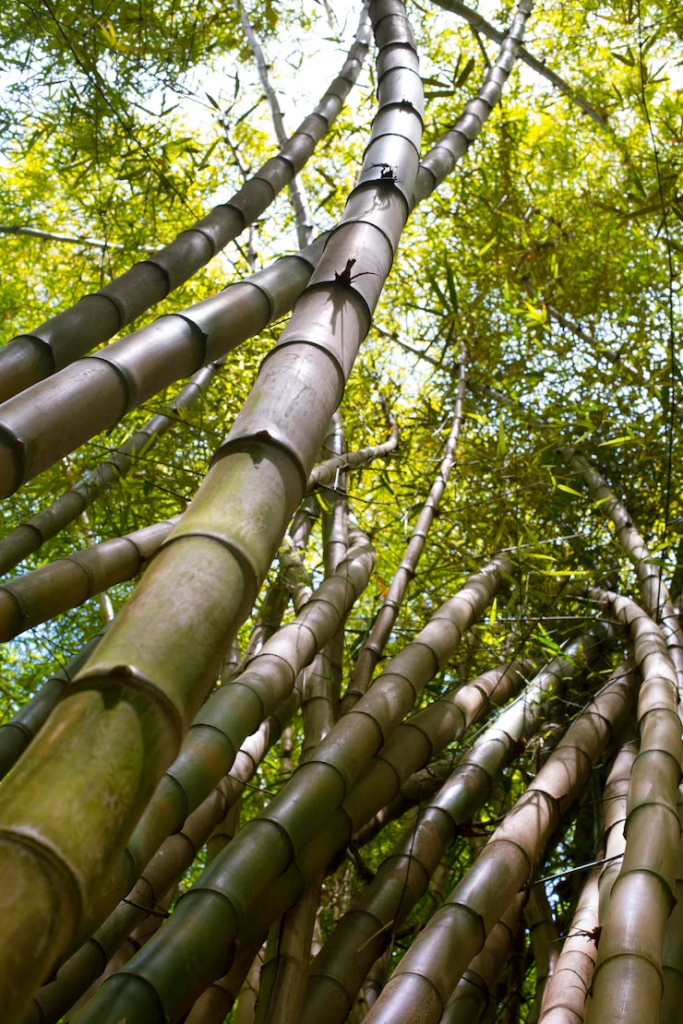Bamboo as a Sustainable Building Material in 2025
Introduction: The Green Revolution in Construction
The modern world is facing an environmental crisis, with industries contributing significantly to deforestation, carbon emissions, and pollution. Among these industries, construction is one of the largest consumers of natural resources, contributing nearly 40% of global carbon emissions.

To counteract this damage, sustainable building materials are gaining momentum, and one material stands out as a game-changer—bamboo. Known for its rapid growth, durability, and eco-friendliness, bamboo is proving to be a viable alternative to traditional materials like steel, concrete, and timber.
In this article, we will explore bamboo’s strength, versatility, applications, challenges, and the latest case studies that highlight its growing importance in the construction sector.
Why Bamboo? A Natural Wonder
1. Unparalleled Growth Rate
Unlike trees that take decades to mature, bamboo reaches its full height in just 3 to 5 years. Some species can even grow up to 35 inches per day, making it one of the fastest-growing plants on the planet. This rapid regeneration allows for continuous harvesting without deforestation.
2. High Strength-to-Weight Ratio
Despite its lightweight structure, bamboo has a higher tensile strength than steel (up to 28,000 psi) and greater compressive strength than concrete. This makes it suitable for load-bearing structures, scaffolding, and even earthquake-resistant buildings.
3. Carbon Sequestration and Oxygen Production
Bamboo acts as a carbon sink, absorbing up to 35% more carbon dioxide than trees while releasing more oxygen into the atmosphere. This makes it a crucial player in climate change mitigation.
4. Cost-Effectiveness
Bamboo is affordable compared to traditional building materials. It is widely available, lightweight, and easy to transport, reducing construction costs significantly.
5. Versatility in Construction
Bamboo can be used for flooring, roofing, walls, scaffolding, furniture, and entire buildings. Architects and engineers are now designing high-rise bamboo structures and bridges that challenge the dominance of concrete and steel.
Comparing Bamboo with Traditional Materials
| Feature | Bamboo | Concrete | Steel |
|---|---|---|---|
| Sustainability | High (Rapid regrowth) | Low (Mining & pollution) | Low (High energy use) |
| Strength-to-Weight Ratio | Very High (Stronger than steel per weight) | Medium | High |
| Durability | High (Treated bamboo lasts 50+ years) | Very High | Very High |
| Carbon Footprint | Negative (absorbs CO₂) | High | Very High |
| Cost-Effectiveness | Affordable | Expensive | Expensive |
| Flexibility | Very High (Earthquake-resistant) | Low | Medium |
Applications of Bamboo in Construction
1. Structural Framework
- Used for beams, columns, scaffolding, and bridges.
- Provides earthquake-resistant flexibility.
- Used in bamboo skyscrapers in Asia and Latin America.
2. Flooring and Decking
- Bamboo flooring mimics the elegance of hardwood while being more sustainable.
- Resistant to wear and tear when properly treated.
- Used for indoor and outdoor decks.
3. Roofing and Ceilings
- Lightweight and weather-resistant.
- Provides natural insulation, reducing energy consumption.
4. Walls and Partitions
- Enhances aesthetic appeal with a natural finish.
- Soundproof and temperature-regulating properties.
5. Furniture and Interior Design
- Used for chairs, tables, shelves, cabinets, and decorative panels.
- Adds aesthetic value to eco-friendly homes and offices.
Challenges and Solutions in Bamboo Construction
| Challenge | Solution |
| Short Natural Lifespan | Treatment with boric acid prevents decay and pests. |
| Moisture Susceptibility | Proper sealing prevents water damage and mold growth. |
| Fire Resistance | Chemical treatments improve fire resistance. |
| Standardization Issues | New ISO standards are improving bamboo construction regulation. |
Case Study: Green School Bali, Indonesia
Project: Green School Bali
Architect: John Hardy
Objective: To construct a sustainable school entirely out of bamboo.
Results:
✔️ Reduced construction waste by 70%.
✔️ Created a carbon-negative campus.
✔️ Inspired bamboo skyscrapers in Asia.
Lesson Learned: Bamboo is more than a building material—it is a movement toward sustainable architecture.
Bamboo’s Contribution to Carbon Reduction
| Factor | Bamboo | Concrete |
| CO₂ Absorption | High (absorbs CO₂) | None |
| Carbon Emission | Negative (stores CO₂) | High |
| Production Energy | Low (grows naturally) | Very High |
📊 Studies suggest increasing bamboo use in construction could cut carbon emissions in the building sector by 30%.
Future Trends in Bamboo Construction
🔹 Bamboo Skyscrapers – Engineers are designing high-rises made entirely from bamboo. 🔹 3D-Printed Bamboo – Future technologies aim to print bamboo structures for rapid, low-cost housing. 🔹 Bamboo Composite Materials – Stronger than traditional wood composites, opening new applications in furniture and architecture.
FAQs
1. Is bamboo stronger than wood?
✔️ Yes! Bamboo has higher tensile strength than most hardwoods.
2. How long does a bamboo house last?
✔️ Properly treated bamboo can last 50+ years with minimal maintenance.
3. Can bamboo replace concrete and steel?
✔️ In certain applications, yes! Bamboo is being used for bridges, houses, and even high-rise buildings.
4. Is bamboo expensive?
✔️ Compared to traditional materials, bamboo is affordable and cost-effective.
Conclusion: The Future of Bamboo in Construction
Bamboo is not just an alternative building material—it is a game-changer in sustainable architecture. Its high strength, rapid renewability, and eco-friendly properties make it an ideal solution for modern green buildings.
As the world shifts toward carbon-neutral construction, bamboo will play a crucial role in reducing emissions, cutting costs, and promoting a circular economy.
💡 Isn’t it time to embrace this natural powerhouse for a greener future?
💚 Take Action: Build Sustainably with Bamboo!
👷 Looking to incorporate bamboo into your next project? Contact eco-friendly builders and suppliers today!
👉 Find Bamboo Builders Near You! (Insert CTA Button Here)
📢 Join the green revolution! Share this article to spread awareness about sustainable building materials!
